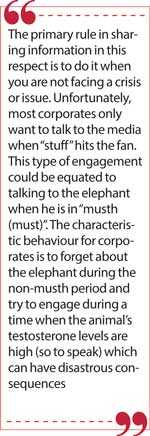Sunday Dec 15, 2024
Sunday Dec 15, 2024
Wednesday, 31 July 2019 00:00 - - {{hitsCtrl.values.hits}}
Talking to elephants... needs special skill. Not everyone is a mahout, and everyone would not consider it necessary to have these skills, as most people do not encounter these large beasts in their day to day run-ins. However, if  one happens to have a large pachyderm in the room, some kind of conversation needs to happen — ignoring the elephant would not be advisable on any scale.
one happens to have a large pachyderm in the room, some kind of conversation needs to happen — ignoring the elephant would not be advisable on any scale.
In my last article, I pointed to the important fact of building relationships when developing a brand identity and the way in which media and PR can work with each other. Its focus was how important it was to talk to content creators, rather than chucking one press release after another down their throats.
Many times during my PR career, I have been asked the question — what do I say to the beast? A light, in which journalists are often viewed — especially news reporters and columnists who are usually an unknown quantity for PR and Corp-Com specialists, and therefore best left alone. The primary reason for this being that reporters and columnists are considered unpredictable.
So, are they unpredictable? The answer by far, is yes — their behaviour patterns most often resemble that of a Rottweiler rather than a Labrador. Be that as it may, they have to be engaged, if one has to manage one’s message — primarily to inform and educate.
In my experience, journalists most often write misinformed reports (meaning, one-sided stories) because those who are supposed to respond (from the corporate sector) maintain a ‘no comment’ stance or simply close their doors to sharing information.
The primary rule in sharing information in this respect is to do it when you are not facing a crisis or issue. Unfortunately, most corporates only want to talk to the media when “stuff” hits the fan. This type of engagement could be equated to talking to the elephant when he is in “musth (must).”
The characteristic behaviour for corporates is to forget about the elephant during the non-musth period and try to engage during a time when the animal’s testosterone levels are high (so to speak) which can have disastrous consequences. 
There is always a cry from corporates for favourable reporting in the media during an issue, sometimes dangling their advertising spend as a carrot to mitigate a situation. But herein lies the problem; the news columns in newspapers usually are not connected to advertising column centimetres. So any organisation trying to make a news reporter understand how much they spend on advertising in order to turn the story positive, is as good as howling in the wind. Denying the story and crying it’s untrue will also not help in the long run. So what does one do?
Journalists don’t claim to write the truth, the whole truth and nothing but the truth, in their articles. As I have pointed out in several of my articles in the past, there is no “truth” in the media. In this, I quote Edward de Bono, the father of lateral thinking, who says that what is in the media is just perception.
Don’t get me wrong, I don’t mean that the media reports are all a pack of lies or what we in these days, call fake news. De Bono’s statement reveals that the general public have a wrong understanding of what “truth” really is, from a media perspective. The media deals with facts and when they investigate the who, what, where, and when of a story. No doubt, when they go into the why’s and how’s of a story, they are attempting to seek the “truth” or what is perceived as the ‘truth.’ But often, this is only a version of the truth and not conclusive, like in a court of law.
Perception in the media can be categorised as objective and subjective. News reporting generally falls in the objective category, as the news reporter is expected to maintain this stance, i.e. not be influenced by personal feelings or opinions in analysing and representing facts. Subjective writing on the other hand, is opinion based and to a great degree influenced by personal feelings, and carries the writer’s viewpoint on the subject. These articles are found in the opinion pages.
I could go as far to say it is not truth that the media tries to present but what is ‘fair, accurate and balanced,’ and their focus should be more on facts when reporting news. And yes, at this point we can get into a discussion/argument that the truth and fact is one and the same, but to me they aren’t. But that’s another story altogether.
So how does one talk to the elephant in the room? The elephant being the news reporter and his editor, in this case, people who have the power to impact an entity with what they write. Are they monsters as some perceive?
I have been a news reporter and the head of a news division which produced about 134 news bulletins every day. I agree I may not have been the easiest of people to deal with, especially when PR people wanted to meet me. Most found it difficult to get their foot in the door, but that was entirely due to the fact that the PR person did not have the skill to get my attention.
Attention
The attention span of a news journalist is very short, and there is only a very limited time to get through to him/her. So if and when a PR person gets the chance to engage, they have to frame their story like an elevator pitch, meaning if you only have the time to sell something to a fellow passenger in a lift between the 1st and 10th floor.
One has to be well prepared, as there would hardly be much time to set the base to the story i.e. walking the journalist/editor through the ABCs of it. Therefore, it is an absolute necessity to study the newspaper and what the particular journalist has written on the subject, before attempting to engage. You need to tell them something new that would get their attention, in order to break the ice.
You also need to know the structure in which the reporter (journalist) thinks. It is the way he/she would write a story i.e. important matters on top — the inverted pyramid.
But that is not all, a journo will never believe a PR or Corp Com person on the face of it, however virtuous that person might be. That goes with the territory, therefore transparency is the key to the PR person’s credibility — never lie to a journo. If there is a problem, be open about it. It is probable that one cannot tell them the whole story due to various reasons but no untruths please.
Think story
News reporters will only be willing to spend time with you if they see potential in your story, otherwise they would consider it a waste of their time.
The corporate sector must understand clearly that a news reporter is usually not looking for a story where there is no conflict. What is conflict? It is a dispute, a quarrel, disagreement, difference of opinion, discord, fall out, clash, or feud, for which a resolution is required, and the story spans between these two points.
So talking to journos from a Corp Com/PR perspective is not as easy as sending a press release, but it can have a better impact on the brand in resolving contentious issues, especially if one has developed a healthy relationship with the reporter.
Above all, from a PR angle, one must know that the crisis by itself and what is reported in the media are not directly proportional. I mean when the crisis is full blown you can minimise impact in the media and thereby bad publicity. On the other hand, a small issue can be blown out of proportion in the media, causing considerable damage to the brand. The outcome depends on how one manages the message!
Corporates need to develop skills to talk to journalists and there aren’t any shortcuts. It may be painful at times and risky — but it is worth the try as will certainly bring good results in the long haul.
(To be continued – Making the elephant a part of the conversation)
(The writer is a PR specialist, who was a senior journalist in both print and electronic media.)